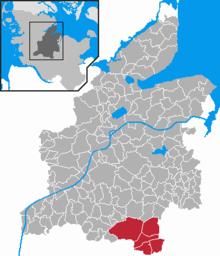Office Aukrug
The Aukrug office was an office in the Rendsburg-Eckernförde district in Schleswig-Holstein . Most recently, about 6000 inhabitants lived in the four municipalities on an area of 115 km²:
history
After Schleswig-Holstein was annexed by Prussia , the districts of Innien (today's municipality of Aukrug and Meezen ) in the district of Rendsburg and Wittorf (municipalities of Arpsdorf, Ehndorf, Padenstedt, Wasbek and Wittorf) in the Kiel district were formed in 1889 . After the dissolution of the Bordesholm district, as the Kiel district was now called, the municipalities of the Wittorf district without Wittorf came as the Wasbek district in 1932 in the Rendsburg district. In 1948, the areas of the administrative districts became today's offices. The Wasbek office remained unchanged compared to the administrative district. The Innien office gave Meezen to the Hohenwestedt-Land office .
On December 31, 1969, the communities of Bargfeld, Böken, Bünzen, Homfeld and Innien, which previously formed the district of Innien, merged to form the temporarily free community of Aukrug. On April 1, 1970, the Aukrug office was formed from the municipality of Aukrug and the municipalities of the previous office of Wasbek.
From January 1, 2007, the administrative business of the office was carried out as part of an administrative community by the municipality of Hohenwestedt .
The municipality of Wasbek left the office on June 15, 2008 and has been administered by the city of Neumünster ever since .
On January 1, 2012, the municipalities of the Aukrug office merged with the municipalities of the Hanerau-Hademarschen and Hohenwestedt-Land offices and the Hohenwestedt municipality to form the Mittelholstein office .
coat of arms
Blazon : "In red a golden wagon wheel with five spokes, accompanied in a circle by five silver acorns turned outwards."
The five acorns symbolize the originally five member communities.

